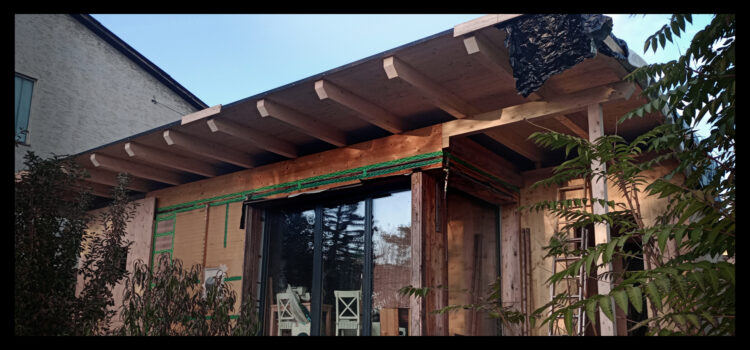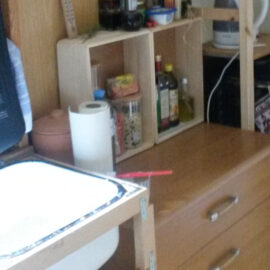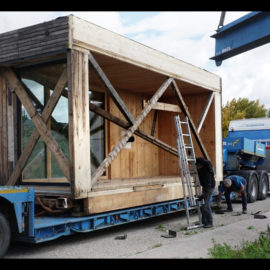
After the preparations and the addition of the new rooms, my house is unfortunately far from finished. After another break of about 3-4 weeks, the time had finally come: I got a roof over my head!
And it was urgently needed! But one thing at a time…
Re-use is easier said than done
It’s important to me not to throw things away unnecessarily, but to look for ways to reuse them. And that’s what I wanted to do with my roof. When I bought the original house, I also got some extra timber. And these piles of wood have reminded me every day for two years that I live on a building site and that there is still a lot to do (but that’s how it is when you have collector’s genes…).
In addition, my father and I had been able to save a lot of wood from the dismantling of another roof. But both the extra wood from the house and that from the roof was not perfectly uniform. All the beams had a slightly different thickness, width and/or length.
So that meant a lot of work at first, sorting out the wood and making it usable in the first place, as there were still nails or screws in it.

All the necessary preparation has shown me why most people simply throw away and buy new. The alternative is simply far too expensive because of the extra labor required. Or the new wood is too cheap. Depending on how we want to look at it.
Those who can do the math have a clear advantage
It was also more difficult to calculate the required area for the roof with the existing timber because it was difficult to know how much waste would be produced due to all the different lengths and widths. But I knew that I didn’t have enough timber for the entire roof. It was therefore a wild mixture of old and “new” wood. But in the end, we mostly used new wood and there was a lot more of the old wood left over than I thought. But better too much than too little.
Well wrapped
The first structural step was to insulate the roof before the superstructure was installed. And here, too, my ingenious building colleague had a clever recycling idea: some of the old cross-laminated timber panels from the original building had been in the rain for too long and were no longer attractive or usable for building. What’s more, almost every board here had different dimensions. So you couldn’t really use them for anything useful.
So we simply piled all the slabs that had been lying in front of my house the whole time and had cased me a headache anyway, onto the roof. Just put them into the two pool-like indentations like Tetris, fill the gaps with material similar to perlite, and I’ve got about 20-24cm more insulation and also reused old material.

It’s dripping
One of the worst things that can happen to a house is a leaking roof. And the whole 2-3 months I had a tarpaulin roof, there was always a bit of unease as to whether it would really hold. And whether there wasn’t a hole somewhere that was slowly leaking into my house and/or my straw insulation.
And apart from one evening back in August, when we had just removed the old roof but hadn’t spread the tarpaulin over roof, because we hadn’t expected it to rain on that fateful evening, the tarpaulin held up really well. My drainage system with various hoses for the pools on the roof had also become very sophisticated and rarely needed any adjustments.
So when we spread the tarpaulin over my roof for what turned out to be the last time, after doing the insulating wood work, I wasn’t really too worried anymore.
But it’s probably a law of nature that when you least expect it, it comes all the more:
In the middle of the night – well actually it was 3 or 4 in the morning – I wake up to a drip , drip, drip. So sleep was over and I went up to the roof to find the place where it might be leaking. I then had to drain off the water at that spot and hope that the insulation layers could dry out reasonably well.

Needless to say, after that night I was really overripe for a tight, stable roof.
Roofs are more complex than you think
Once we had finished with the insulation, we started on the structure for the actual roof, i.e. the part that makes the whole thing watertight. For this, we used the mixture of bought and collected boards that I mentioned at the beginning. It was an extra 4 cm thick so that I could possibly green the roof in the future.
The roof foil (Resitrix) was another science in itself. Several sheets welded together. And then there was one roll too few!
In between, I had to organize and coordinate the tinsmith, although at the time I had no idea which work steps were to be carried out when and how, and when he needed what and how.

There was also a bit of trepidation because it rained again between the individual steps until the roof was finished, and it wasn’t entirely clear whether it was tight enough. Even though it was much safer than with the tarpaulin.
The façade is not just a façade
Even though the façade itself is not part of the roof, the installation of the façade was closely linked to the roof construction. After all, it is also an essential part that protects the house against rain and the like.
It is therefore not just decorative, but also important for protecting the other materials used. And when it was finally assembled in most parts, it really gave me another big boost of enthusiasm and the feeling that my “housy” will soon really look like a “housy” and not like a pathetic, naked chick.

A story of ice and fire
Even though I was happy that I had a tight roof, there was still one essential part missing: the stovepipe!
In August and also in very warm September and October, I could get by just fine without firing up my wood stove. But at the end of October and the beginning of November, the cooler temperatures arrived. And when the thermometer slips below 15°C inside, I also start to regularly warm my fingers under the blanket that I’ve long since thrown over me while I’m working.
So I think it’s understandable that I was very relieved when the roof duct for the stove pipe was finally delivered, and I was actually able to heat up in time before the first sub-zero temperatures hit outside.
Interim conclusion with a roof
It now feels like a big chunk of the extension has been completed. I hardly have to shiver when it rains or snows. And my house, which until recently was almost completely wrapped in a white tarpaulin, now only has a tarpaulin on one of the door openings. Almost everything now looks like a house and not like a building site.
And I could already have doors if I hadn’t spent far too long trying to find used doors on willhaben. At some point, I decided that a proper, secure door was definitely a good idea. But now, delivery times keep me on my toes…

Building the roof definitely taught me how important the work of a good tinsmith is. How important it is to have a secure, tight roof over your head, and also how much more time it takes to finish the small finishings.
I now have all the walls, the roof and the façade. Almost all the rough, big, visible things. And yet I’m probably only halfway through the total work.



